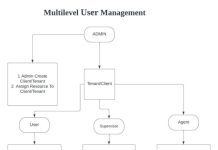In today’s rapidly evolving digital landscape, the importance of secure remote access for businesses cannot be overstated. With the rise of remote work, organizations are increasingly vulnerable to security threats, making robust remote access solutions crucial for protecting sensitive data and maintaining operational integrity. The shift towards telecommuting has profound implications for security protocols, necessitating advanced measures to safeguard against cyber threats. This article aims to explore top secure remote access solutions, providing insights into how businesses can enhance their security posture while accommodating the growing demand for remote work flexibility.


What is Secure Remote Access?
Secure remote access refers to the ability of users to connect to their organization’s network from a remote location, using the internet, while ensuring that the data and communications are encrypted and protected from unauthorized access. In the current business environment, where remote work has become a norm, secure remote access is vital for maintaining the confidentiality, integrity, and availability of business-critical information. It safeguards against common threats and vulnerabilities such as data breaches, malware attacks, and phishing schemes, which are increasingly prevalent with the expansion of remote access points. Ensuring secure remote access is crucial for businesses to protect their assets and maintain trust with their customers and partners.
Factors to Consider When Choosing a Secure Remote Access Solution
When choosing a secure remote access solution, several critical factors must be carefully considered to ensure the selection effectively meets the organization’s needs while providing robust security.
Compatibility is paramount; the solution should integrate smoothly with the organization’s existing technological ecosystem. This includes compatibility with hardware, operating systems, and any specialized software the business relies on. A mismatch here could lead to additional costs or, worse, security vulnerabilities.
Scalability is essential as well. The chosen solution must be able to grow with the organization, accommodating increasing numbers of users and potentially more complex access requirements without significant performance degradation or the need for a complete system overhaul.
Ease of use and management significantly impacts the adoption rate among users and the administrative burden on IT staff. A solution that is intuitive for end users reduces training time and support calls, while one that simplifies management tasks like adding users, setting permissions, and monitoring access helps maintain security without overtaxing IT resources.
Comprehensive security features are the core of any remote access solution. This includes not only robust encryption standards to protect data in transit but also measures like multi-factor authentication and dynamic access controls to ensure that only authorized users can access sensitive systems and information.
Finally, cost-effectiveness and ROI are crucial considerations. The solution should offer value for money, not just in terms of the purchase price or subscription fees, but also considering the total cost of ownership, including maintenance, support, and any necessary training. Balancing upfront costs against the long-term benefits of improved security and operational efficiency is key to making a wise investment.
Selecting a secure remote access solution requires a holistic approach, taking into account how well it fits within the existing infrastructure, its capacity to grow with the company, ease of use and management, the level of security provided, and its overall cost-effectiveness and potential ROI.
Top 5 Secure Remote Access Solutions for Businesses
A. VPN (Virtual Private Network)
VPN technology establishes a secure, encrypted tunnel between a user’s device and a remote network, enabling the transmission of data across public networks as if the devices were directly connected to the private network. Key features include encryption, user authentication, and access control, which collectively enhance security and privacy. VPNs are beneficial for businesses as they provide a reliable and secure way to access corporate resources remotely, support a wide range of devices, and are relatively easy to implement. However, potential drawbacks include slower internet speeds due to encryption, the possibility of IP address leaks, and the risk of using insecure VPN protocols. Businesses must consider these factors and choose reputable VPN solutions with strong security measures.
B. Zero Trust Network Access (ZTNA)
ZTNA is based on the Zero Trust security model, which operates under the principle that no entity inside or outside the network is trusted by default. Instead, access is granted based on strict identity verification and the least privilege access principle. This approach offers significant advantages over traditional models by providing more granular security controls and minimizing the attack surface. However, implementing ZTNA can be challenging, requiring a thorough assessment of current security policies and infrastructure. Best practices include continuous monitoring, multi-factor authentication, and micro-segmentation to ensure secure and controlled access to network resources.
C. Remote Desktop Services (RDS)
RDS allows users to access applications and data on a remote server as if they were physically present at the location. This technology supports multiple sessions on a single hardware resource, making it cost-effective and scalable. The benefits of using RDS include centralized management, access to resources from any location, and the ability to leverage existing infrastructure. However, drawbacks include potential latency issues, the requirement for a reliable internet connection, and security risks associated with exposing internal networks. To mitigate these risks, businesses should implement strong authentication methods, encryption, and regular security updates.
D. Cloud-Based Remote Access Solutions
The shift towards cloud computing offers businesses flexibility, scalability, and cost savings. Cloud-based remote access solutions allow users to connect to their work environments from anywhere, using any device with internet access. These solutions often come with robust security, compliance, and management features, including encryption, multi-tenancy support, and identity and access management. Examples include Amazon WorkSpaces and Microsoft Azure Virtual Desktop. The main benefits are reduced IT overhead, enhanced security, and agility. However, businesses must carefully consider data sovereignty and compliance requirements when adopting cloud-based solutions.
E. Secure Access Service Edge (SASE)
SASE represents an emerging framework that combines comprehensive WAN capabilities with cloud-native security functions (such as secure web gateways, firewalls as a service, and zero trust network access) into a single, integrated cloud service. This approach simplifies network architecture and security, offering businesses enhanced performance, improved security posture, and reduced complexity. SASE enables secure and fast cloud adoption by providing consistent security policies across all locations and users. The future outlook for SASE is promising, as it aligns with the increasing demand for secure, remote access solutions that support the dynamic nature of modern workforces and cloud-based resources.
Conclusion
The importance of secure remote access solutions has never been more pronounced, serving as the backbone for today’s increasingly remote workforces. Businesses are encouraged to diligently assess and upgrade their remote access security measures to combat evolving cyber threats. As the landscape of remote work and security continues to evolve, staying ahead with robust, flexible solutions is paramount for safeguarding critical data and ensuring operational resilience.
















